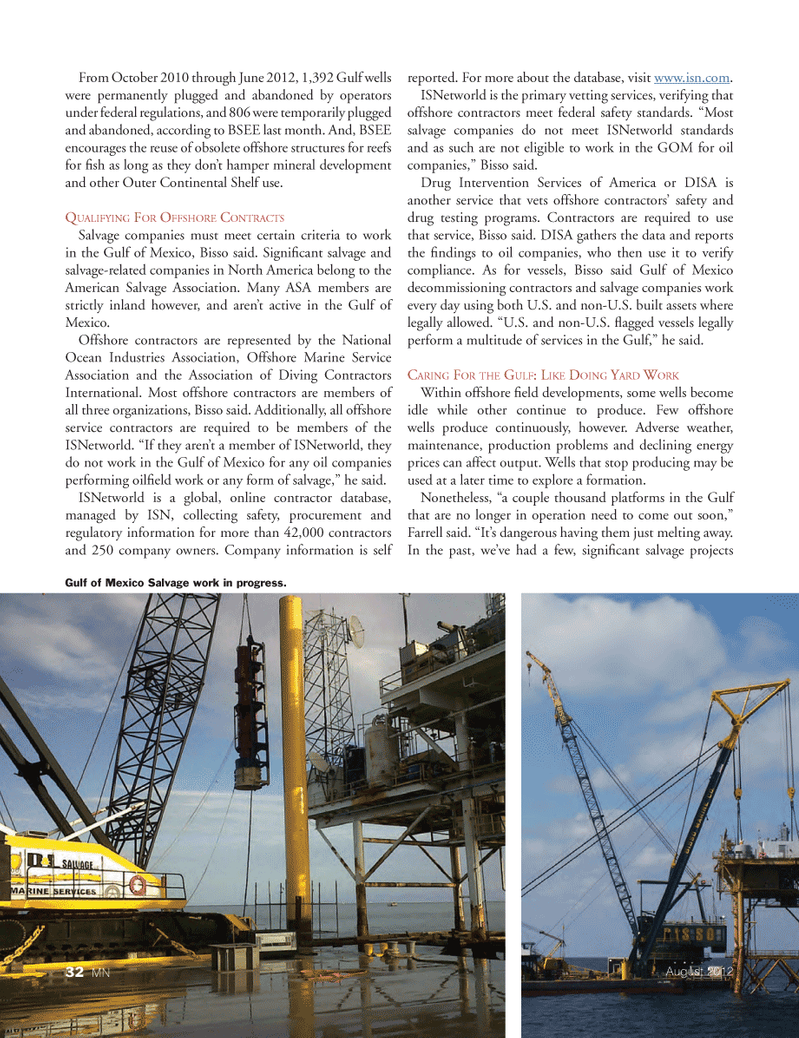
Page 32: of Marine News Magazine (August 2012)
Salvage & Recovery
Read this page in Pdf, Flash or Html5 edition of August 2012 Marine News Magazine
From October 2010 through June 2012, 1,392 Gulf wells were permanently plugged and abandoned by operators under federal regulations, and 806 were temporarily plugged and abandoned, according to BSEE last month. And, BSEE encourages the reuse of obsolete offshore structures for reefs for Þ sh as long as they donÕt hamper mineral development and other Outer Continental Shelf use. QUALIFYING FOR OFFSHORE CONTRACTS Salvage companies must meet certain criteria to work in the Gulf of Mexico, Bisso said. SigniÞ cant salvage and salvage-related companies in North America belong to the American Salvage Association. Many ASA members are strictly inland however, and arenÕt active in the Gulf of Mexico. Offshore contractors are represented by the National Ocean Industries Association, Offshore Marine Service Association and the Association of Diving Contractors International. Most offshore contractors are members of all three organizations, Bisso said. Additionally, all offshore service contractors are required to be members of the ISNetworld. ÒIf they arenÕt a member of ISNetworld, they do not work in the Gulf of Mexico for any oil companies performing oilÞ eld work or any form of salvage,Ó he said. ISNetworld is a global, online contractor database, managed by ISN, collecting safety, procurement and regulatory information for more than 42,000 contractors and 250 company owners. Company information is self reported. For more about the database, visit www.isn.com .ISNetworld is the primary vetting services, verifying that offshore contractors meet federal safety standards. ÒMost salvage companies do not meet ISNetworld standards and as such are not eligible to work in the GOM for oil companies,Ó Bisso said. Drug Intervention Services of America or DISA is another service that vets offshore contractorsÕ safety and drug testing programs. Contractors are required to use that service, Bisso said. DISA gathers the data and reports the Þ ndings to oil companies, who then use it to verify compliance. As for vessels, Bisso said Gulf of Mexico decommissioning contractors and salvage companies work every day using both U.S. and non-U.S. built assets where legally allowed. ÒU.S. and non-U.S. ß agged vessels legally perform a multitude of services in the Gulf,Ó he said. CARING FOR THE GULF: LIKE DOING YARD WORKWithin offshore Þ eld developments, some wells become idle while other continue to produce. Few offshore wells produce continuously, however. Adverse weather, maintenance, production problems and declining energy prices can affect output. Wells that stop producing may be used at a later time to explore a formation. Nonetheless, Òa couple thousand platforms in the Gulf that are no longer in operation need to come out soon,Ó Farrell said. ÒItÕs dangerous having them just melting away. In the past, weÕve had a few, signiÞ cant salvage projects Gulf of Mexico Salvage work in progress. August 201232 MN

 31
31

 33
33
